Autoencoder
Variational autoencoder architecture. Made with https://github.com/battlesnake/neural.

Download
Code
autoencoder.typ (61 lines)
autoencoder.tex (29 lines)
Variational autoencoder architecture. Made with https://github.com/battlesnake/neural.
